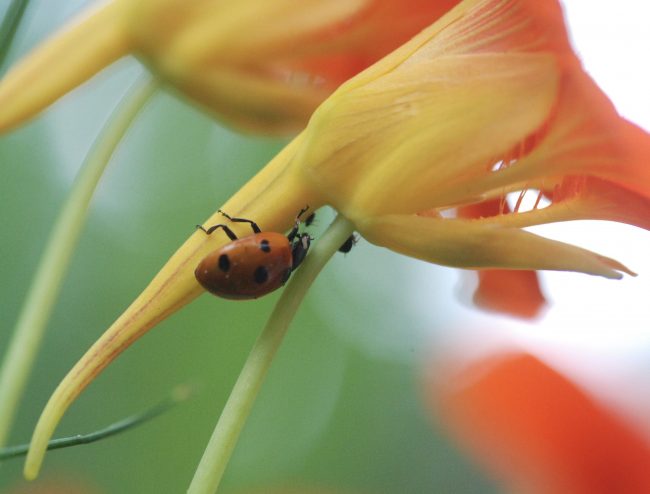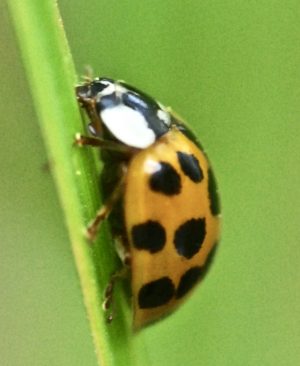Ladybirds or bishy barnabees.

In Norfolk, a ladybird is sometimes referred to as a bishy barnabee.; this rather curious name is explored in this article in The Spectator from last year. Ladybirds are beetles and are easy to recognise. Most have dome-shaped bodies, with an oval outline and three pairs of jointed legs. The most common ladybirds have bright red wing cases with black spots covering their bodies. Others are yellow with black spots, some white and brown, or even striped. It has been estimated that there are some five thousand species of ladybird across the world, with 40+ species in the British Isles.
Their bright colour serves as a ‘do not eat me’ warning to would-be predators, apparently they have a bitter taste. Birds such as swifts and swallows eat ladybirds, as do some spiders, frogs, wasps, and dragonflies. When challenged, ladybirds can produce an ‘unpleasant’, yellow, oily fluid; or they may ‘play dead’. The pine ladybird when under threat ‘clamps’ itself to the surface that it is resting on. Bright colours are used as a defence mechanism in a number of insects.
Ladybirds themselves feed on aphids and small insects - most are voracious carnivores. During its lifetime, a single ladybird can eat thousands of aphids - no wonder gardeners like them.

Stalking an aphid
However, there are ladybirds such as the orange ladybird that are not carnivorous - instead they feed on mildews found in tree canopies of ash and sycamore. The 22 spot ladybird (yellow with many black spots) also feeds on mildews, and may be found on hogweeds (and trees).
Like many insects, the life cycle of the ladybird has four stages: egg, larva, pupa and adult (imago).
 Ladybirds lay eggs one or more times a year (it varies from species to species) in batches (up to forty eggs) on the underside of leaves. The eggs are yellow or orange and hatch after 4-10 days (partly depending on temperature).
Ladybirds lay eggs one or more times a year (it varies from species to species) in batches (up to forty eggs) on the underside of leaves. The eggs are yellow or orange and hatch after 4-10 days (partly depending on temperature).- The larvae that emerge vary in colour and markings. The colour varies from grey, yellow and brown according to species - sometimes with spots. The larvae do not resemble the adults. During its time as a larva, the ladybird will shed its ‘skin’ (exoskeleton) four times (in order to grow, and like the adult it feeds hungrily) then it attaches itself to a leaf or stem and becomes a pupa.
- The pupal stage is a phase during which the body plan is reorganised. The insect is undergoing metamorphosis. After some two weeks or so, the adult form emerges.
- When the adult form emerges, its skin or exoskeleton is soft at first (and the insect is quite vulnerable) but over the next few hours the wing cases and exoskeleton hardens and the distinctive colours and patterns form.
In the winter months, adult ladybirds hibernate in cracks, crevices (of bark, sheds, buildings), under rocks and in leaf litter. For example, the pine ladybird overwinters in the bark crevices of evergreen trees (and their leaf litter) and the same is true of the larch ladybird. Adult ladybirds emerge in April to find a mate and begin the cycle again.
Unfortunately, several of our native species of ladybird are threatened by the arrival and spread of the Harlequin ladybird. The CEH continues to monitor the status of our native ladybirds.
There is a smart phone App - European Ladybirds, which is not only an aid to identifying the various ladybird species, but also allow you to report sightings (but see note below about compatibility to various phones). There is also a number of different apps dealing with identification of a wide range in insects.
Comments are closed for this post.

The app “European ladybirds” mentioned here is probably out of date for many, including myself. I tried to download it but was informed that I could not, as it was designed for older android devices, and mine is already two years old.
Vincent
15 August, 2023